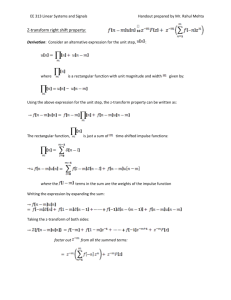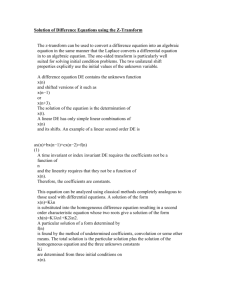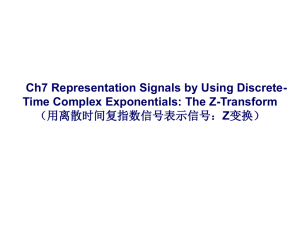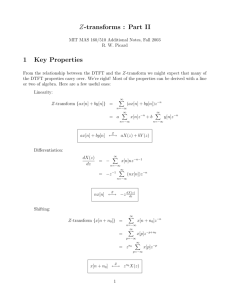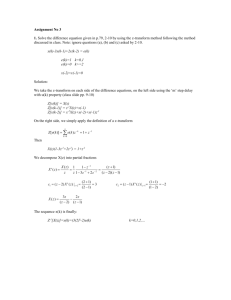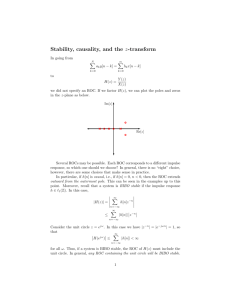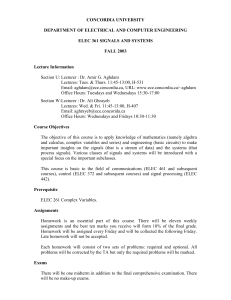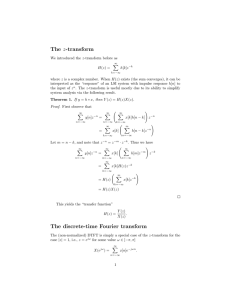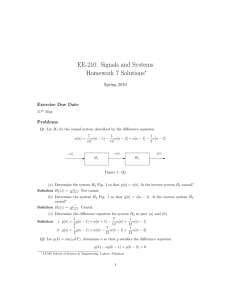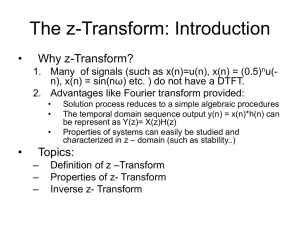22 The z-Transform
advertisement
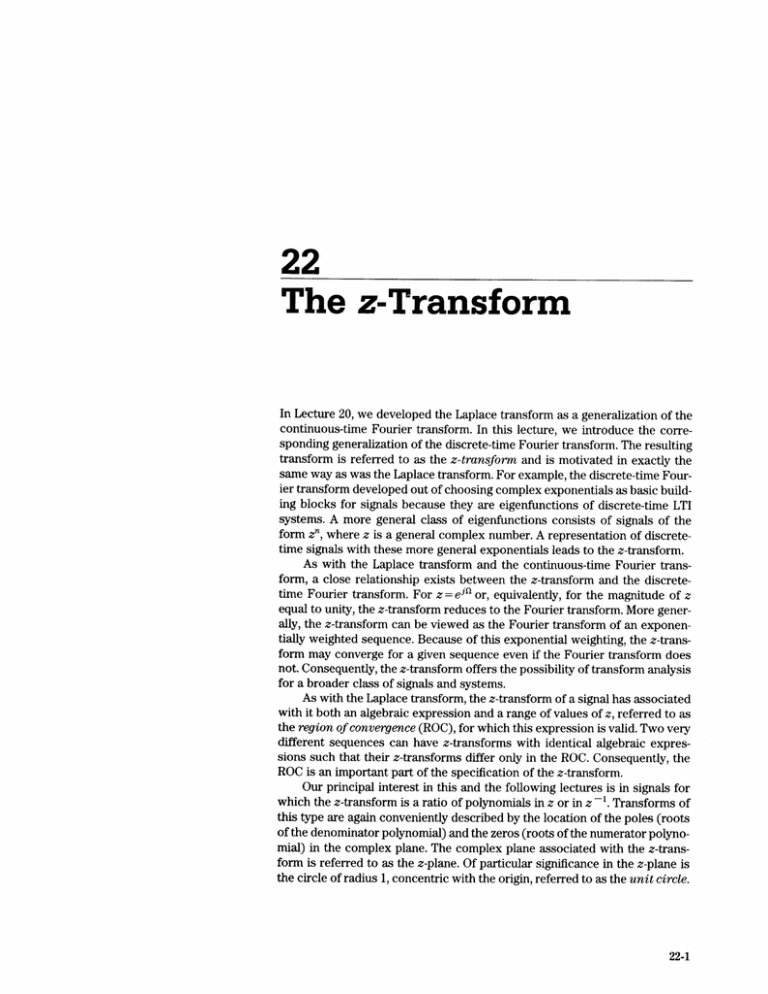
22
The z-Transform
In Lecture 20, we developed the Laplace transform as a generalization of the
continuous-time Fourier transform. In this lecture, we introduce the corresponding generalization of the discrete-time Fourier transform. The resulting
transform is referred to as the z-transform and is motivated in exactly the
same way as was the Laplace transform. For example, the discrete-time Fourier transform developed out of choosing complex exponentials as basic building blocks for signals because they are eigenfunctions of discrete-time LTI
systems. A more general class of eigenfunctions consists of signals of the
form z, where z is a general complex number. A representation of discretetime signals with these more general exponentials leads to the z-transform.
As with the Laplace transform and the continuous-time Fourier transform, a close relationship exists between the z-transform and the discretetime Fourier transform. For z = ejn or, equivalently, for the magnitude of z
equal to unity, the z-transform reduces to the Fourier transform. More generally, the z-transform can be viewed as the Fourier transform of an exponentially weighted sequence. Because of this exponential weighting, the z-transform may converge for a given sequence even if the Fourier transform does
not. Consequently, the z-transform offers the possibility of transform analysis
for a broader class of signals and systems.
As with the Laplace transform, the z-transform of a signal has associated
with it both an algebraic expression and a range of values of z, referred to as
the region of convergence (ROC), for which this expression is valid. Two very
different sequences can have z-transforms with identical algebraic expressions such that their z-transforms differ only in the ROC. Consequently, the
ROC is an important part of the specification of the z-transform.
Our principal interest in this and the following lectures is in signals for
which the z-transform is a ratio of polynomials in z or in z 1.Transforms of
this type are again conveniently described by the location of the poles (roots
of the denominator polynomial) and the zeros (roots of the numerator polynomial) in the complex plane. The complex plane associated with the z-transform is referred to as the z-plane. Of particular significance in the z-plane is
the circle of radius 1, concentric with the origin, referred to as the unit circle.
22-1
Signals and Systems
22-2
Since this circle corresponds to the magnitude of z equal to unity, it is the contour in the z-plane on which the z-transform reduces to the Fourier transform. In contrast, for continuous time it is the imaginary axis in the s-plane on
which the Laplace transform reduces to the Fourier transform.
The pole-zero pattern in the z-plane specifies the algebraic expression
for the z-transform. In addition, the ROC must be indicated either implicitly or
explicitly. There are a number of properties of the ROC in relation to the poles
of the z-transform and in relation to characteristics of the signal in the time
domain that often imply the ROC. For example, if the sequence is known to be
right-sided, then the ROC must be the portion of the z-plane outside the circle
bounded by the outermost pole. This and other properties are discussed in detail in the lecture.
Suggested Reading
Section 10.0, Introduction, page 629
Section 10.1, The z-Transform, pages 630-635
Section 10.2, The Region of Convergence for the z-Transform, pages 635-643
Section 10.3, The Inverse z-Transform, pages 643-646
The z-Transform
22-3
MARKERBOARD
22.1
bisc rp-e-Ti me.
{c
L-TT
2i . Tr u
es Srm
SIjS4cb1S
H((3)~
lbv1pwi$c repvvs
wteo6
Ne+Am~
'X[V%) * -7 V, 'X(3)
I
MARKERBOARD
22.2 (a)
E-XCILV to.Jle
fal.1
On
y
27, x C.'3 sq
V%---Jo
+
L
Vr
VIM-do
I
-too
xr"l
n--QQ
r
"T
]
Ickio
e)rtUk%pI.lc
t
f )(chi V,-Vt
I
Signals and Systems
22-4
Im
Unit circle
TRANSPARENCY
22.1
The z-plane and the
unit circle.
Z
= ej&
z-p lane
Re
TRANSPARENCY
22.2
The z-transform and
associated pole-zero
plot for a right-sided
exponential sequence.
The z-Transform
22-5
TRANSPARENCY
22.3
The z-transform and
associated pole-zero
plot for a left-sided
exponential sequence.
TRANSPARENCY
22.4
Pole-zero plot for a
discrete-time underdamped secondorder system
illustrating the
geometric determination of the Fourier
transform from the
pole-zero plot.
Signals and Systems
22-6
PROPERTIES OF THE REGION OF CONVERGENCE
TRANSPARENCY
22.5
Properties of the ROC
of the z-transform.
. The ROC does not contain poles
. The ROC of X(z) consists of a ring in the
z-plane centered about the origin
. y7x[n][converges <=>
ROC includes the unit
circle in the z-plane
. x [n] finite duration => ROC is entire z-plane
with the possible
exception of z = 0 or
z = oo
. Ix
TRANSPARENCY
[n
22.6
Properties of the ROC
for a right-sided
sequence.
ITITI
N1
Sx [n] right-sided and IzI= r. is in ROC
=> all finite values of z for which iz I> r0
are in ROC
. x[n] right-sided and X(z) rational
=> ROC is outside the outermost pole
1.
-
-
0 & 0
n
The z-Transform
22-7
.
[n] left-sided and Iz|= ro is in ROC
=> all values of z for which 0 < Iz I< r0
will also be in ROC
x
TRANSPARENCY
22.7
Properties of the ROC
of the z-transform for
a left-sided sequence
and for a two-sided
sequence.
. x[n] left-sided and X(z) rational
=> ROC inside the innermost pole
. x [n] two-sided and Iz I= r is in ROC
=> ROC is a ring in the z-plane which
includes the circle Iz|= rI
TRANSPARENCY
22.8
Transparencies 22.822.10 show ROCs for a
specified algebraic
expression for the ztransform. Shown here
is the ROC if the
sequence is rightsided.
Signals and Systems
22-8
x(z)
z
=
_
_
_
_
_
(Z Z ) (Z - 2)
TRANSPARENCY
22.9
The ROC if the
sequence is left-sided.
Im
Unit circle
z-plane
X-
x(z)=
TRANSPARENCY
22.10
The ROC if the
sequence is two-sided.
(z -
Re
z
) (zZ 2)
Im
Unit circle
z-plane
Re
I--
The z-Transform
22-9
MARKERBOARD
22.2 (b)
MIT OpenCourseWare
http://ocw.mit.edu
Resource: Signals and Systems
Professor Alan V. Oppenheim
The following may not correspond to a particular course on MIT OpenCourseWare, but has been
provided by the author as an individual learning resource.
For information about citing these materials or our Terms of Use, visit: http://ocw.mit.edu/terms.
